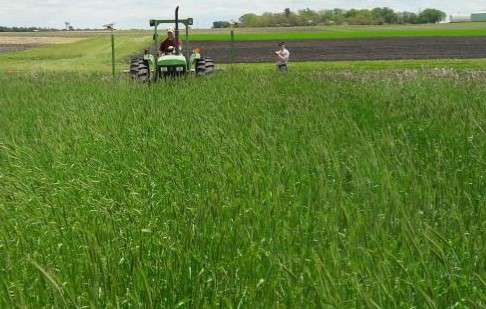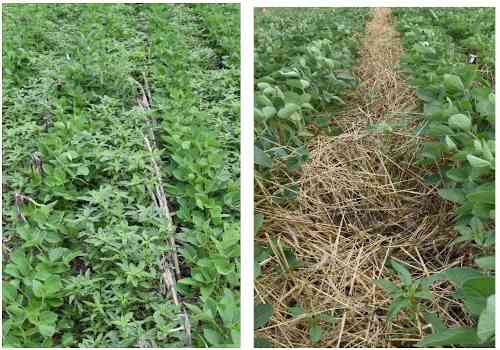By Prashant Jha
Current cooler weather conditions are posing challenges for growers with a cereal rye cover crop to get it terminated. However, for growers planning to plant soybeans into the rye cover crop, there may be a perk to letting the rye cover crop accumulate more biomass. That perk being the cover crop biomass can help with weed suppression. The ability of cereal rye to suppress weeds is directly related to the biomass accumulation at the time of termination.

Figure 1: Soybean planting in a living cereal rye cover crop (planting green) at the Iowa State University Research Farm, Boone, IA in 2020.
Research Overview
Field experiments were conducted at two locations (Ames, IA and Boone, IA) in 2019-2020. Cereal rye cover crop (var. Elbon) was drill seeded at 60 lb/a in 2nd week of October, 2019 and terminated with Roundup (glyphosate 1.12 lb ae/a) at different timings in spring 2020 (Table 1). No cover crop plots were kept fallow until soybean planting.
Table 1. Cereal rye cover crop termination timing and biomass accumulation at the Iowa State University Research Farms, IA in 2020.
Study Location | Cover crop termination dates | Cover crop biomass accumulation (lb/a) |
|---|
|
Ames, IA | May 6, 2020 (7 d before soybean planting) | 2142 |
| Ames, IA | May 13, 2020 (at soybean planting) | 3287 |
| Boone, IA | May 27, 2020 (14 d after soybean planting) | 5731 |
Boone, IA | May 22, 2020 (at soybean planting) | 4658 |
In the field trial conducted in Ames, IA, comparisons were made between different cereal rye termination timings on weed suppression. The cover crop terminated 14 days after soybean planting accumulated greater biomass (Table 1) and provided higher levels of marestail (horseweed) and waterhemp suppression compared to termination dates of 7 days before soybean planting or at soybean planting.
In the field trial conducted in Boone, IA, comparisons were made between a cereal rye cover crop that was terminated at the time of soybean planting (Figure 1; Table 1) vs. a no cover crop treatment. Cereal rye accumulated 4658 lb/acre biomass and provided greater than 30% reduction in waterhemp emergence (density) during the growing season compared to no cover crop plots. In addition to reductions in waterhemp density, the cover crop residue reduced the size and biomass of the waterhemp plants at the time of postemergence (POST) herbicide application (Figure 2). The cover crop resulted in greater than 65% reduction in waterhemp seed production compared with no cover crop plots. In this study, soybean emergence, growth, canopy development, and grain yields were not affected when the cereal rye cover crop was terminated at soybean planting compared to no cover crop plots.

Figure 2. Effect of cereal rye cover crop terminated at soybean planting on waterhemp emergence and growth in soybean at the Iowa State University Research Farm, Boone, IA in 2020.
Cover crop biomass and residual herbicides
Based on the results from our field studies in 2020, terminating the cereal rye cover crop at or after soybean planting (planting green) didn’t eliminate the need for a preemergence soil residual herbicide. A residual herbicide (Prefix 32 oz/a) applied at the time of cereal rye termination with glyphosate as a burndown program provided better waterhemp control six weeks after soybean planting, compared to glyphosate only burndown program or when Prefix 32 oz/a was applied at the POST timing. A residual herbicide with multiple sites of action applied as PRE along with a high-biomass cover crop termination would reduce selection pressure on POST herbicides, a best management practice (BMP) to manage herbicide resistance.
Although not observed in our 2020 field trials, a high biomass cover crop (delayed termination) may cause physical tie-up of the soil residual herbicide for a longer period, thereby reducing the availability in the soil where preemergence herbicides are active. Applying the preemergence herbicide early POST rather than with the burndown treatment may be an alternative option, especially for waterhemp control later into the season. However, this strategy limits preemergence products that can be applied following soybean emergence. On-going research and on-farm trials conducted over multiple locations in Iowa will help in better understanding the cover crop termination timing by herbicide interactions and the effect of climate variables across years.
In conclusion, cover crops cannot reliably replace other forms of weed control, but this integrated weed management (IWM) strategy would reduce herbicide selection pressure while improving weed control with herbicides when herbicide-resistant weeds are a problem.
Source : iastate.edu